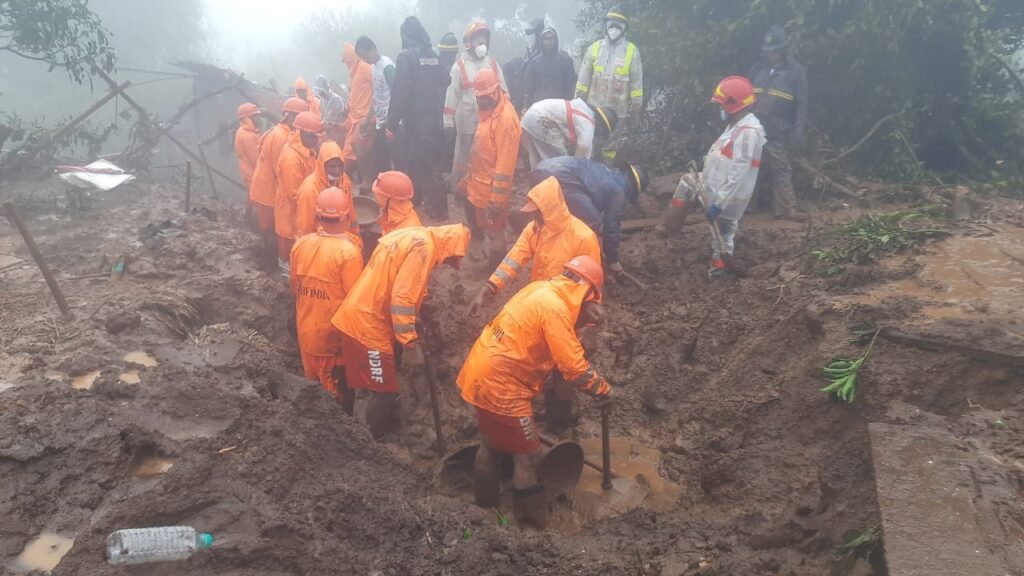Physical Address
23,24,25 & 26, 2nd Floor, Software Technology Park India, Opp: Garware Stadium,MIDC, Chikalthana, Aurangabad, Maharashtra – 431001 India
Physical Address
23,24,25 & 26, 2nd Floor, Software Technology Park India, Opp: Garware Stadium,MIDC, Chikalthana, Aurangabad, Maharashtra – 431001 India

By Aayushi Sharma
More than one hundred people were reported to be trapped after a landslide struck Irshalwadi village in the Raigad district of Maharashtra recently, affecting about 48 families and leaving at least 16 people dead. The landslide caused extensive damage to over 17 of the almost 50 houses in the area.
The landslide affected a tribal community on a hillside in the Khalapur tehsil, 80 kilometers from Mumbai. The bodies of 16 of the village’s 228 residents have been found by officials, and 93 residents have been identified. Due to the rough terrain and persistent rain, rescue operations have been arduous.
Data from the India Meteorological Department show that 17 out of 28 of Raigad’s dams overflowed as a result of many locations in the district receiving more than 200 mm of rain in a 24-hour period. More than 2,200 people were evacuated from Raigad as the heavy rain continued in order to prevent more deaths.
About Raigad:
Raigad, one of the districts in Maharashtra’s Konkan Division and Arabian Sea coast forms the western boundary of the district. The most hilly areas of the district are In the Sahyadri mountain. It was changed from being known as Kolaba to Raigad District in 1981. The district headquarters is at Alibaug.
Irshalwadi Village: not on the landslide-prone list
According to Chief Minister Eknath Shinde, Irshalwadi village, which was hit by a massive mudslide, was not on the list of landslide-prone locations which were drawn up for rehabilitation. Irshalwadi has no history of landslides.
“The (landslide) vulnerability mapping of all the villages with their core and buffer zones was completed and a list of those villages, which are prone to landslides, was prepared. Irshalwadi was not in the list of landslide-prone villages,” said Deputy CM Fadnavis.
What factors have led to landslides in the Irshalwadi region?
Environmentalists are extremely concerned about the persistent soil erosion in the region, which is mostly due to the absence of vegetation and constant quarrying, excavating, and construction activity nearby. The Sahyadri mountain range’s landscape has become extremely susceptible as a result of these circumstances, putting the lives of those living in the foothills at serious risk.
Activists also blame uncontrolled quarrying for these disasters. As a result, they demand that all quarries operating across the hills be immediately prohibited and that the eco-sensitive areas in the Raigad and Thane districts be thoroughly investigated.
The regular use of high-intensity blasts has substantial adverse effects since it weakens the soil on hill slopes and raises the possibility of landslides, according to NatConnect Foundation and Shri Ekvira Aai Pratishthan (SEAP). According to a news article, these groups emphasized the necessity of taking the necessary steps to protect the area’s environment and avert potential disasters in an email sent to Chief Minister Eknath Shinde.

A 552 page report by The Gadgil commission which was formed by the Ministry of Environment in 2010 to study the impact of population pressure, climate change and development activities on the Western Ghats, submitted to Ministry of Environment, Forest and Climate Change (MoEF&CC) in 2011, had some suggestions were not implemented. The report recommended that the Western Ghats, which span six states and 64 percent of the region, should be divided into ESZs 1, 2, and 3. It also advocated for the designation of the entire area as an ESA (Ecologically Sensitive Area). The panel had encouraged the Ministry of Environment Forests and Climate Change, to take important actions to involve the public, such as proactive and sympathetic implementation of the Community Forest Resources provisions of the Forest Rights Act.
The Gadgil Commission report was followed by the Kasturirangan report by a High-Level Working Group on Western Ghats under former Indian Space Research Organization (ISRO) chief Dr K Kasturirangan, constituted by the then Environment Minister Jayanthi Natarajan In August 2012. The Gadgil committee report’s recommendation for a rigorous ecological control over the Western Ghat complex through modifications and regulations on farming practices was not included in the study. This report favored the establishment of a new body to control regional development and economic expansion. A news report states that it was formed as stakeholder states resisted the implementation of the recommendations of the Gadgil amid fears of hindrance to development and loss of livelihood. The recommendations, however, were only partially implemented.
According to Indian ecologist Madhav Gadgil, who headed the Gadgil commission, the following are the primary reasons for such an incident taking place:
Does climate change play any role in the unexpected landslides?
Disasters brought on by landslides have multiplied tenfold during the previous 50 years. Additionally, due to two growing trends—urbanization and climate change—the risk of landslides is expected to increase. Researchers must now predict where and how much these dangers will increase.
When gravity overrides the restraining forces of soil or rock on an inclination, a mass slides, falls, or flows downward. This is known as a landslide. The main cause of landslides is heavy rainfall; as water seeps into the ground, it increases the pressure in pore spaces and weakens the soil. Generally speaking, a hillslope will be more unstable the steeper it is and the weaker the material it is built of. Plant roots, for example, could offer some strength.
Slopes that have been altered by humans may be more susceptible to failure. They become steeper and hence more unstable when they are cut into for terracing or to flatten the ground for dwellings or roadways. The risk of landslides is also increased by clearing vegetation and adding water due to inadequate drainage or leaking pipes.
References: